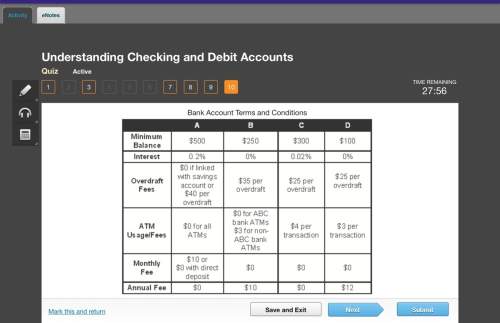
Business, 01.12.2021 07:20 evanwall91
How does the opportunity cost principle explain the relationship between the real interest rate and investment spending?
As the interest rate rises,
the more spending businesses want to do.
the less attractive it is to leave money in the bank instead of spending on investments.
the more attractive it is to leave money in the bank instead of spending on investments.
it has no effect on investment spending. If firms need to expand, they will invest regardless of the interest rate.
b. The investment line is
because of the relationship between real interest rates and investment
spending
perfectly elastic
vertical
upward-sloping
downward-sloping

Answers: 1


Another question on Business

Business, 22.06.2019 17:00
Afinancing project has an initial cash inflow of $42,000 and cash flows of −$15,600, −$22,200, and −$18,000 for years 1 to 3, respectively. the required rate of return is 13 percent. what is the internal rate of return? should the project be accepted?
Answers: 1


Business, 22.06.2019 23:30
Sports leave thousands of college athletes with little time for their studies. this is an example of
Answers: 1

Business, 23.06.2019 19:00
The unadjusted trial balance of the manufacturing equitable at december 31, 2018, the end of its fiscal year, included the following account balances. manufacturing’s 2018 financial statements were issued on april 1, 2019. accounts receivable $ 114,250 accounts payable 53,600 bank notes payable 670,000 mortgage note payable 1,270,000 other information: the bank notes, issued august 1, 2018, are due on july 31, 2019, and pay interest at a rate of 12%, payable at maturity. the mortgage note is due on march 1, 2019. interest at 11% has been paid up to december 31 (assume 11% is a realistic rate). manufacturing intended at december 31, 2018, to refinance the note on its due date with a new 10-year mortgage note. in fact, on march 1, manufacturing paid $263,000 in cash on the principal balance and refinanced the remaining $1,007,000. included in the accounts receivable balance at december 31, 2018, were two subsidiary accounts that had been overpaid and had credit balances totaling $19,650. the accounts were of two major customers who were expected to order more merchandise from manufacturing and apply the overpayments to those future purchases. on november 1, 2018, manufacturing rented a portion of its factory to a tenant for $32,400 per year, payable in advance. the payment for the 12 months ended october 31, 2019, was received as required and was credited to rent revenue. required: (1) prepare any necessary adjusting journal entries at december 31, 2018, pertaining to each item of other information (2) prepare the current and long-term liability sections of the december 31, 2018, balance sheet. balance sheet (partial) at december 31, 2018 current liabilities: total current liabilities long-term liabilities:
Answers: 1
You know the right answer?
How does the opportunity cost principle explain the relationship between the real interest rate and...
Questions



Biology, 21.07.2019 21:00

Mathematics, 21.07.2019 21:00

Social Studies, 21.07.2019 21:00


History, 21.07.2019 21:00




History, 21.07.2019 21:00

Mathematics, 21.07.2019 21:00



History, 21.07.2019 21:00

Health, 21.07.2019 21:00


Mathematics, 21.07.2019 21:00

Mathematics, 21.07.2019 21:00





